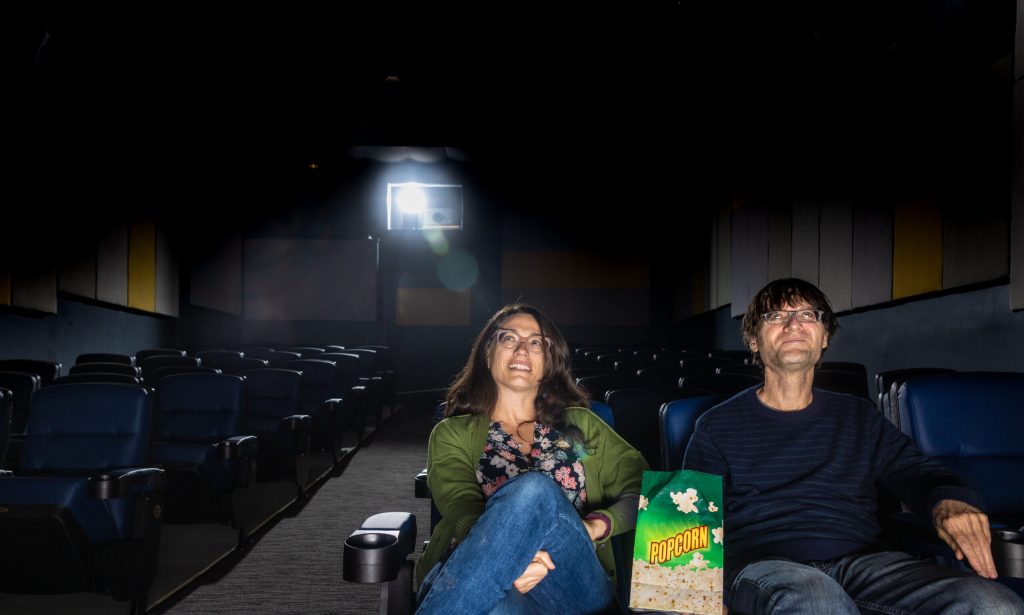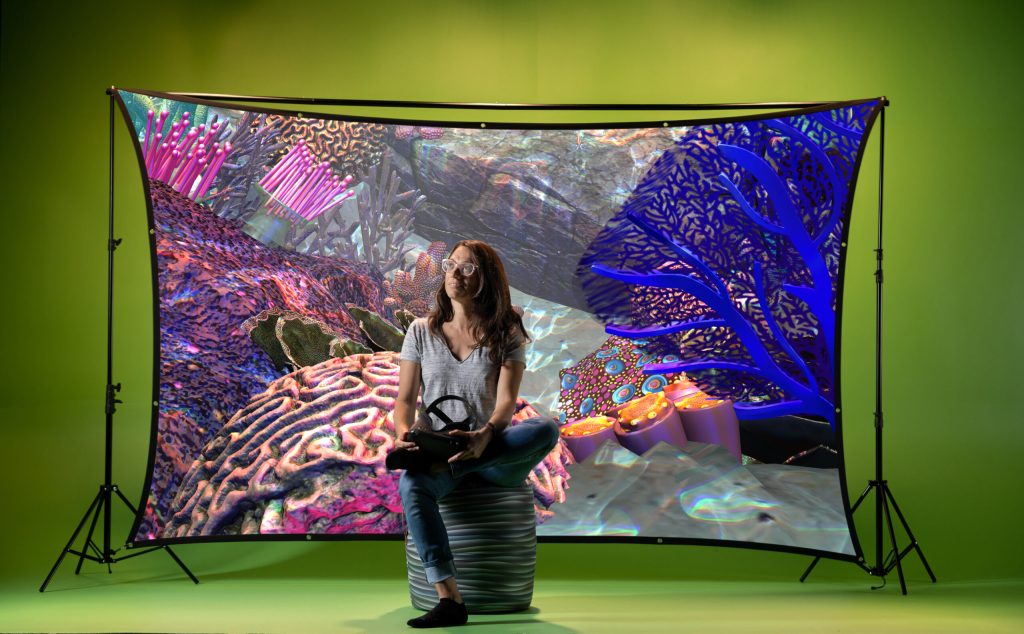Five years in, the Cosmic Rays Film Festival continues to provide a venue for experimental filmmakers in Chapel Hill.

Sabine Gruffat is used to creating her own space in the art world. At 14, she was living in New York City and about to enter high school. She enrolled in a painting course that was part of the continuing education curriculum at the prestigious Parson School of Design. They were night classes, and Gruffat was by far the youngest artist in the class. On the first day, students were asked to bring in a painting for the instructor to critique.
“I remember he absolutely destroyed it,” Gruffat says. “He critiqued me in front of the whole class, like everything that was wrong with what I was doing. I felt like an idiot at first, but then I remember being totally fine with it. It didn’t really upset me. When I showed up for the second class, he was just so surprised to see me. He said, ‘I didn’t think you’d come back.’ It made a huge impression on him.”
Twenty years later, it was that same persistence that motivated Gruffat to launch the Cosmic Rays Film Festival with her husband and collaborator Bill Brown. When she and Brown first arrived in Chapel Hill in 2011, the lack of local venues for experimental films was frustrating both as artists and teachers.
“There was kind of a void around experimental film when we got here,” Gruffat says.
For the past several decades, the Triangle has had a lively cinema scene centered around feature-length narrative and documentary filmmaking. Brown points to the Full Frame film festival, a sprawling, three-day international event held in Durham to spotlight documentary films.
“The Full Frame film festival is a really wonderful and pretty prestigious documentary film festival,” Brown says. “It’s great, but for our niche — artist cinema, experimental cinema, and personal cinema — there was nothing at all when we got to Chapel Hill.”
As a professor of digital art in the UNC-Chapel Hill Department of Art & Art History, Gruffat knew how valuable the festival experience would be for her students. Cosmic Rays was an attempt to create that space locally.
“It’s hard to teach video classes or animation classes when the students aren’t exposed to the things I’m teaching. They don’t see how it operates in the context of the real world. And so, this allows them to see there is this life beyond school where you can be creative and make work that will be shown.”
Today, the festival shows no signs of slowing down. The most popular screening at last year’s festival had 500 people in attendance at the Forest Theatre and, this year, Gruffat and Brown are on track to receive a record number of artists’ submissions.
Cosmic convergence
Neither Gruffat nor Brown can remember one incident that spurred them to put on Cosmic Rays, but they recount several things converging. They were having their own conversation about trying to collaborate on an exhibition project. At the same time, people were recognizing that there was an absence of experimental programming.
“It kind of emerged organically,” Brown says. “I think we were excited, but also in the spirit of experimentation.”
The Cosmic Rays film festival launched in 2018. The first year, they screened at the Varsity Theater, a downtown venue with a rich history for Chapel Hillians.
“We had this great scenic downtown with a two-screen movie house. It was kind of a perfect venue,” Brown says.
It’s been a screening location for every festival since.
Gruffat also invited a visiting curator through the Hanes Visiting Artists Program: David Dinnell, the former artistic director of the Ann Arbor Film Festival, the oldest experimental film festival in the country.
Attendance throughout the festival was high, and feedback from artists was enthusiastic.
The inaugural Cosmic Rays was a success, and Brown admits they got lucky for their first festival. That success helped push them into the future.
Festival fundamentals
As they’ve grown, Cosmic Rays has sought funding for support. It has been awarded the Orange County Arts Commission Grassroots Arts Program and Artist Project Grant twice, and it was just awarded its first Spark the Arts grant. Awarded by the North Carolina Arts Council, the grant is designed to encourage live programming around the arts after the pandemic. They partnered with the UNC-Chapel Hill art initiative, Arts Everywhere, for funding.
“I think it’s incredibly important as a university to have this tie to something like Cosmic Rays,” says Kathryn Wagner, associate director of Arts Everywhere. “It encourages students to think about how they’re pushing the boundaries with their own creations. Art isn’t meant to sit in a box.”
Arts Everywhere was also a partner through the National Endowment for the Arts Grant (NEA) application process and, for the second year in a row, they received a grant.
“We were excited because it’s really hard to get those grants, and we were kind of a nobody,” Gruffat says. “That grant really put us on the map in a big way because there’s a lot of festivals that don’t get grants. This next festival is going to be the biggest one so far because it got more money than we’ve ever had, and we’ve learned a lot.”
This year’s grant, like the first, is earmarked for the Cosmic Rays month-long digital exhibition at Lump Gallery in Raleigh, which will run concurrently with the film festival. Patrons will interact with the art through VR Goggles, iPads and other various electronic media.
The exhibition is an extension of the ideas Gruffat explores in her own research, and Brown believes it shows how her work is fundamental to the idea behind Cosmic Rays.
“Definitely all the aspects of the festival come out of both of our research interests,” Brown says. “But I think the variety of Sabine’s research interests is connected to every facet of the festival. In fact, it recapitulates many aspects of Sabine’s research.”
Gruffat works with communications technologies across video, photography, augmented reality and virtual reality, examining how technology affects the way that the work is received. She describes her work as a mix of Neil Postman and Marshall McLuhan. Postman wrote the acclaimed cultural criticism, “Amusing Ourselves to Death,” and McLuhan is a well-known communication theorist who coined the phrase: “The medium is the message.”
“The way that I think about it is that I don’t have much to say,” Gruffat admits. “But I’m interested in exploring how the discourse has changed because of the internet and social media. I’m interested in the speed at which dialog happens and the way tribes form through these technologies.”
Gruffat studied film at the Rhode Island School of Design. She learned 3D computer animation and design programs like Adobe After Effects and Photoshop, but most importantly, she learned those tools during a crucial moment in filmmaking when analog was transitioning to digital. When she started school, her cohort was still shooting on 16mm film and analog video, and by the time she graduated, they had switched to digital video, oftentimes learning new technologies right alongside the teacher.
“I think that one of the reasons why I’m not tied to any particular technology is because I’ve had experience with so many different technologies, and I can see how they affect the way things look.”

Growth and ingenuity
For her most recent project, Gruffat taught herself how to use a video game software called Unity. Although it’s intended for the design of the “open-world” 3D environments common to the medium, Gruffat is using it in a collaboration with Brian Naess, a GIS Analyst with the UNC Institute for the Environment. Naess is studying reefs in the Caribbean Sea and using data to create a 3D version of one of those reefs.
“My role on the project is a combination of science advisor and database developer,” Naess says. “As science advisor, I work with Sabine to think through how to convey the impact of overfishing and warming sea temperatures on coral reefs and their inhabitants. As a database developer, I find spatial data that classifies the risk of overfishing on reefs around the world.”
That data is updated in real-time and viewers, watching through Augmented Reality goggles, can see the reef change right before their eyes.
“It’s augmented reality and 3D animation,” Gruffat says, “It changes the digital environment based on the actual coral reef. It’s extremely cinematic. It transports you. I’m building this coral reef around you, and it puts you in this whole other space.”
The extra funding Gruffat received with help from Arts Everywhere will help next year’s festival grow, giving Gruffat the ability to hire a docent to oversee the Cosmic Rays Digital Exhibition. Digital art requires patrons to interact with technology, and a docent can help guide someone unfamiliar with an iPad or VR headset.
Gruffat and Brown plan to hire someone to market the festival and maintain the website, pay themselves a stipend and pay the filmmakers.
“The idea is to pay the creators,” Gruffat says. “We try to put the money in their pocket because we think they’re the ones bringing the value.”
Gruffat recognizes that the extra manpower the new funding provides is essential for the festival to continue to grow. She hopes it can grow to include more filmmakers, more immersive exhibits and greater use of virtual and augmented reality.
“There was so much momentum that came out of that first year,” Brown shares. “It’s kind of pushed us along. By launching the festival, it felt sort of like Jacques Cousteau exploring some undersea chasm. It just illuminated what we already had here but didn’t really understand or recognize because we hadn’t connected all the dots before this. We built it. And they came.”
Sabine Gruffat is a professor of digital art in the Department of Art and Art History within the UNC College of Arts and Sciences.
Bill Brown is an associate professor of media and technology in the Department of Communication within the UNC College of Arts and Sciences.
Kathryn Wagner is the associate director of Arts Everywhere.
Brian Naess is a geographic information systems analyst and lecturer at the UNC Institute for the Environment.
By Andrew Russell, Endeavors
